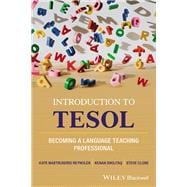A comprehensive introduction to TESOL for new and future teachers of English, offering a full and detailed view of the process of becoming a language teacher
Introduction to TESOL: Becoming a Language Teaching Professional presents an expansive and well-balanced view of both the interdisciplinary knowledgebase and professional opportunities in the field of language teaching. Written to help aspiring TESOL educators understand how to begin their careers, this comprehensive textbook covers both the foundational linguistic elements of TESOL as well as the practical pedagogical aspects of the discipline.
Written with the needs of the introductory student in mind, this book delves into the essentials of English as a Second Language (ESL) and English as a Foreign Language (EFL) teaching, covering professional organizations, language acquisition theories, instructional practices, professional development, and more. Readers are provided with clear descriptions of recent research and contemporary practices, numerous illustrations and examples highlighting key material, and engaging real-world vignettes from professionals teaching internationally. Offering a coherent overview and contextualized orientation of the field of TESOL, this guide:
- Discusses the differences in TESOL approaches in international settings
- Addresses the current state and potential future of TESOL with a view for new developments in teaching pedagogy and language research
- Explores the history and development of the field, including the political, social, and cultural decisions made about language teaching and learning
- Describes the specializations, niches, and subfields within the discipline of TESOL
- Explains what, how and why TESOL educators need a working understanding of linguistics and second language acquisition theories
- Outlines the scope of the profession and how to engage in professional organizations to grow in expertise
Introduction to TESOL: Becoming a Language Teaching Professional is essential reading for students and educators planning to enter this dynamic and rewarding area of language teaching.








